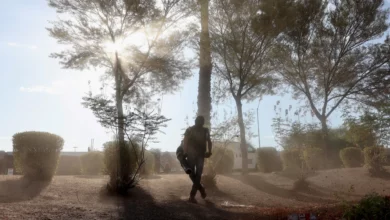It may seem like a random number, but many scientists agree that 350 is one of the most important digits for humanity.
Back in 2007, leading climatologists began arguing that the planet will be on the brink of a climate disaster, with immense human and natural consequences, if atmospheric concentrations of carbon dioxide (CO2) remained above 350 parts per million. Alarmingly, few seem to be mobilized by such information.
Many scientists and environmental activists now have a common interest in drawing attention to this number. While some limit their efforts to the laboratories, others aim to raise awareness through projects like EARTH 350, the world's first global climate art project, large enough to be seen from space.
In a collective effort, green activists in more than a dozen countries around the world created art pieces this past week highlighting the urgency of global warming. In the lead-up to the UN climate talks in Cancun (set to take place from 29 November to 10 December), they hope to show world leaders that action is imperative before it is too late.
Activists in Cape Town, South Africa created an enormous Solar Sun out of 70 high-powered parabolic solar cookers, which they then used to prepare a feast of traditional foods. On the other side of the world, New York City-based artist Molly Dilworth created a map on her apartment rooftop depicting what a submerged New York and New Jersey would look like after a seven-meter rise in sea levels.
In Egypt, activists also gathered for the occasion, though it was no easy task.
An attempt to organize the event at the Pyramids in Giza was unsuccessful due to prohibitions by security officials, according to Hazem Mohamed Saleh, the assistant project coordinator. Instead, the event was held in Wadi al-Natroon, near the Alexandria desert road.
“We’re just a group of individuals,” said Saleh. “We stand now on private land that belongs to Hassan Refaat, who offered it to help us escape the many [state] regulations that would have blocked us.”
Organizers expected the early morning event to attracted over 1000 people from different cities and towns in Egypt. The goal was to create a 70×90 meter traditional Egyptian scarab holding a sun composed of people. The number of attendees, however, did not extend 150. The low turnout created a big problem for organizers since the Satellite company, Global Digital, requested that displays be very big in order to be seen from the sky.
In Ancient Egypt, scarabs were typically associated with re-birth and re-generation. They often depicted the sun being pushed across the sky, causing the passage of day into night. The choice of this symbol for the event was simple: It symbolizes the need to re-examine our relationship with the sun–the most abundant source of clean energy.
“We want to send a strong message to leaders at the UN climate talks,” said Sarah Rifaat, the artist behind the scarab drawing. “We wanted to do something that symbolizes both Egypt and one of the most important clean energy sources in the world: solar power.”
Most participants arrived late due to weather conditions, causing organizers to fear they would miss the satellite feed. Indeed, a satellite picture of the unfinished scarab was published later than expected on Saturday. Meanwhile, activists took an alternative picture from a crane prepared in case the satellite feed was missed.
“I wasn’t expecting a huge turnout,” said Rifaat, “but I expected a bigger number than this. In the end, however, we managed to create the art piece we wanted to and it surpassed my expectations.”
Despite being few in number, many participants felt positive about the impact the event could have in Egypt.
Habiba Helmy, a 21-year-old student at the American University in Cairo, thought the event would help create environmental awareness in Egypt.
“I feel like no one is noticing what’s going on around us in the world,” she said. “We have a global problem, and this event brings it to the attention of our society. It might help change some of the habits of Egyptians for the better.”
Omar Rakha, 16, and Hassan Ismael, 15, were among a group of young students attending the event after they heard about at their school.
“I believe attending this event creates global empowerment,” said Ismael, stressing the event was an effective tool for challenging public apathy.
“Many Egyptians think global warming is not effecting them,” Rakha pointed out. “They think it will only have an impact on the United States and Europe. They don’t realize that it may actually affect Egypt even more.”




